Every Anzac Day Australians and Hellenes remember the periods in history when our two nations were bonded together in the dark days of war. From the role of Lemnos in the Gallipoli campaign to the battles of the Greek campaign of 1941 and beyond, these titanic struggles are at the centre of the Hellenic link to Australia’s Anzac story.
One of the often overlooked elements of that link is the service of the Royal Australian Navy (RAN). Australian warships sailed Greek waters during the First World War, the RAN’s AE2 submarine harbouring at Lemnos. Today I write about the major role played by the Australian Navy during the battle to defend Greece from Axis invasion in the Second World War.
The naval aspect of the Greek campaign stretches from 1940 to 1941.This saw some of the major naval engagements in the Mediterranean during the Second World War. The naval battles of Cape Spada near Crete in July 1940 and Matapan off the western coast of the Peloponnese in March 1941 were great Allied victories, together effectively crippling the Italian Navy’s surface fleet. The German invasion of Greece in April 1941, followed by the battle of Crete in May 1941, would see the combined Allied fleet subjected to devastating aerial bombardment by Axis air forces as it undertook the successful evacuations of Allied land forces, first to Crete and then to Egypt. In the process the Allied fleets ran the gauntlet of sustained enemy air attack, with many ships sunk or damaged and an estimated 2,000 sailors killed.
Nine ships of the RAN took part in these major naval engagements – the cruisers HMAS Perth and HMAS Sydney, the destroyers HMAS Napier and HMAS Nizam, as well as a group of five former First World War British Royal Navy destroyers, re-fitted for the RAN service in the Second World War – HMAS Stuart, HMS Voyager, HMAS Vampire, HMAS Vendetta and HMAS Waterhen. These five would be contemptuously named the “Scrap Iron Flotilla” by Adolf Hitler’s propaganda minister, Josef Goebbels. This title would be adopted with pride by the Australian sailors who served on them.
The role of the RAN in these Greek campaign naval engagements was significant. HMAS Sydney led an Allied naval squadron during the battle of Cape Spada, sinking the Italian cruiser Bartolomeo Colleoni. HMAS Perth, HMAS Stuart and HMAS Vendetta all took part in the great Allied naval victory at Cape Matapan, where three Italian cruisers and two destroyers were sunk with the loss of over 2,000 men, including the Italian Admiral Cattaneo. RAN ships, such as HMAS Perth, formed part of the large Allied fleet that successfully brought Australian and other Allied troops to Greece in March and April 1941. HMAS Perth creating a memorial card of their part in this effort.
The evacuations of Allied forces from the mainland saw six RAN warships – HMAS Perth, HMAS Stuart, HMAS Voyager, HMAS Vampire, HMAS Vendetta and HMAS Waterhen – take part in the successful naval operations evacuating thousands of Allied troops from the harbours and beaches of Porto Rafti, Megara, Nafplio, Tolos and Kalamata between 24th and 29th April. HMAS Waterhen and HMAS Vendetta later took part in the evacuation of troops from Suda Bay on Crete to Alexandria prior to the German invasion of the Island.
I have written in Grecian Adventure how these evacuations could be filled with emotion and danger. Australian troops marching through Kalamata to their evacuation points were moved by the generosity of local Greek women offering them food and drink. The Australian nurses who were evacuated from Nafplio and transported from the harbour in Greek fishing vessels – some still filled with fish – were in danger of falling in the water as they boarded HMAS Voyager out in the bay, one British nurse falling between the vessels saved from crushing by the swift action of an Australian sailor, Ordinary Seaman Cyril “Spider” Webb from North Richmond.
The dangers to ship, crew and passengers during the evacuations of the campaign were real. 500 Australian soldiers were among more than a thousand Allied soldiers killed as their transports were sunk by enemy aircraft after they had sailed from Nafplio. Those Australian troops aboard the transport Costa Rica had to be transferred to other ships after an enemy air attack after it departed Kalamata. Sergeant Alfred Huggins from Victoria wrote of his transport surviving enemy air attack as it headed for Alexandria after departing Crete. Gunner Leonard Hodgson from Templestowe was not so lucky. He was killed when the HMS Hereward was attacked after departing Heraklion as the battle of Crete drew to a close.
RAN warships also took part in the battle of Crete. HMAS Nizam bombarded the Italian airbase at Karpathos (then Scarpanto) to the west of Crete on 20th May, HMAS Perth took part in the destruction of the ill-fated German naval invasion of the Island on 21st May, HMAS Voyager and HMAS Vendetta escorted the British Royal Navy aircraft carrier HMS Formidable for its attack on Karpathos airbase on 26th May and both HMAS Stuart and HMAS Nizam landed Allied reinforcements on Crete in May, the latter delivering the last Allied troops to arrive on Crete prior to the German invasion. HMAS Perth, HMAS Nizam and HMAS Napier all took part in the Allied naval evacuations from Sfakia on Crete between 29th-31st May, all sustaining damage from German air attacks in the process. HMAS Perth suffered a direct hit killing a number of soldiers and four of the crew, one of whom was 20 year old Fitzroy-born Stoker 2nd Class Harry Charles from Spotswood in Victoria who had been in the Navy less than a year when he was killed.
The service of the “Scrap Iron Flotilla” was first told during the war with John Moyes book of the same name published in 1942. Now author and former broadcaster Mike Carlton has written an excellent new book – The Scrap Iron Flotilla – The Valiant Destroyers and the Australian War in the Mediterranean. This follows on from his three previous excellent works on Australian naval history – Cruiser: The life and loss of HMAS Perth and her crew and Flagship: HMAS Australia II and the Pacific War on Japan.
Carlton’s book is not limited to recounting the story of the “Scrap Iron” warships alone but encompasses these along with the other RAN warships who served in the Mediterranean theatre. It is well-researched, drawing on official histories, published and unpublished memoirs of participants, histories of the individual ships and other archival material. It is particularly enriched by his use of personal accounts of Australian naval personnel who served on the warships during the campaign. This research has not hampered Carlton’s trademark engaging and readable style. Readers unused to formal history texts will find the book a cracking read.
The book details the role of the RAN ships across the Mediterranean theatre, protecting Allied convoys, and attacking enemy shipping and supporting the Allied fronts in North Africa. But a major portion of the book focuses on the RAN involvement in the Greek campaign. It covers the sailing of the vessels to the Mediterranean, their first encounters with the enemy, the engagements at Cape Spada and Matapan are covered in great detail, their involvement in transporting Allied troops to Greece in the face enemy air attack and then the dangerous evacuations from the mainland, and finally their part in the battle and evacuations from Crete. He provides portraits of RAN personnel, from leaders such as Benalla-born Captain Hec Waller of HMAS Stuart to individual sailors, providing added personal colour to his account of the Australian Navy in the Greek campaign.
Carlton recounts how the men of the RAN were honoured during the campaign, with Tasmanian-born Captain John Collins of HMAS Sydney being awarded the Order of the Bath for his leadership at Cape Spada. Local newspapers like the Dandenong Journal honoured their local naval heroes, such as HMAS Sydney’s Stoker Cyril Aumann from Narre Warren for his service in the same battle.
The story of the Australian sailors who served in the defence of Greece should not be forgotten. The campaigns on land regularly feature in the annual commemorations held in Greece and Australia. This oversight needs to be corrected. The naval aspects of the campaign are essential to understanding its course and outcome. These brave sailors – and their Allied comrades – took part in some of the most important engagements and operations of the Greek campaign. While no Australian ships were lost, many sustained damage and sailors were killed.
On this basis I can highly recommend Mike Carlton’s latest effort to put a spotlight on Australia’s naval history, including its part in the defence of Greece in 1940-41. His re-telling of this often overlooked part of Australia’s naval history is authoritative and engaging. The naval battles of the Greek campaign – and most importantly Australia’s part in them – needs to be better appreciated and commemorated in both Australia and Greece. Mike Carlton’s new book is a great way for readers to begin that journey.
Mike Carlton’s The Scrap Iron Flotilla is published by Penguin Books and available from all good book stores.
Jim Claven is a trained historian, freelance writer and published author, his most recent works including Lemnos & Gallipoli Revealed: A Pictorial History of the Anzacs in the Aegean (2019) and Grecian Adventure: Greece 1941, Anzac Trail Stories & Photographs (2022). He can be contacted via email – jimclaven@yahoo.com.au
Images
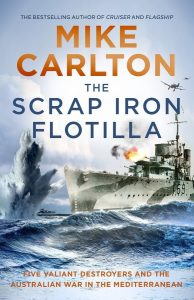 Mike Carlton’s new book on the Scrap Iron Flotilla.
Mike Carlton’s new book on the Scrap Iron Flotilla.
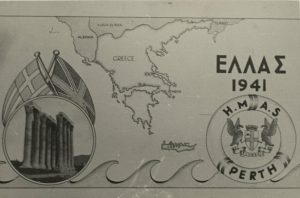 Photographic souvenir commemorating the voyage of HMAS Perth in 1941 escorting Australian troops to Greece. 1941. Courtesy AWM
Photographic souvenir commemorating the voyage of HMAS Perth in 1941 escorting Australian troops to Greece. 1941. Courtesy AWM
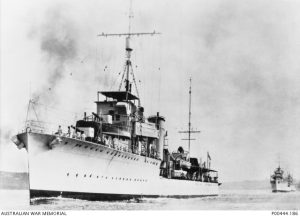
HMAS Stuart. c1941. Courtesy AWM
 Benalla-born Captain Hec Waller of HMAS Stuart, Mediterranean, December 1940. Courtesy AWM.
Benalla-born Captain Hec Waller of HMAS Stuart, Mediterranean, December 1940. Courtesy AWM.
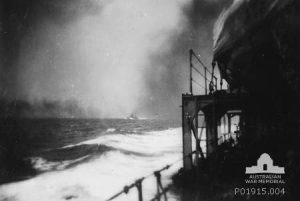 View of smoke screens forward of HMAS Perth during the battle of Matapan. Greece, 28 March 1941. Courtesy AWM
View of smoke screens forward of HMAS Perth during the battle of Matapan. Greece, 28 March 1941. Courtesy AWM
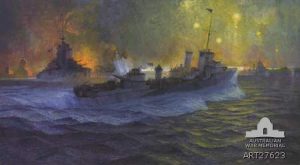 HMAS Stuart (foreground) during the battle of Matapan, 1941. Painting by Frank Norton. Courtesy AWM.
HMAS Stuart (foreground) during the battle of Matapan, 1941. Painting by Frank Norton. Courtesy AWM.
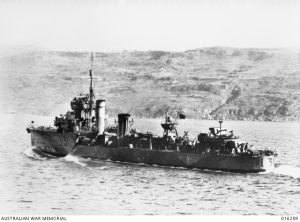 HMAS Voyager at sea off Suda Bay, Crete, 25 May 1941. Courtesy AWM.
HMAS Voyager at sea off Suda Bay, Crete, 25 May 1941. Courtesy AWM.
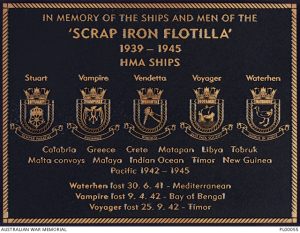 Bronze commemorative plaque to the “Scrap Iron Flotilla” installed in the grounds of Australian war Memorial in Canberra in 2002. Courtesy AWM.
Bronze commemorative plaque to the “Scrap Iron Flotilla” installed in the grounds of Australian war Memorial in Canberra in 2002. Courtesy AWM.
Contact MHHV Friend about this article.






